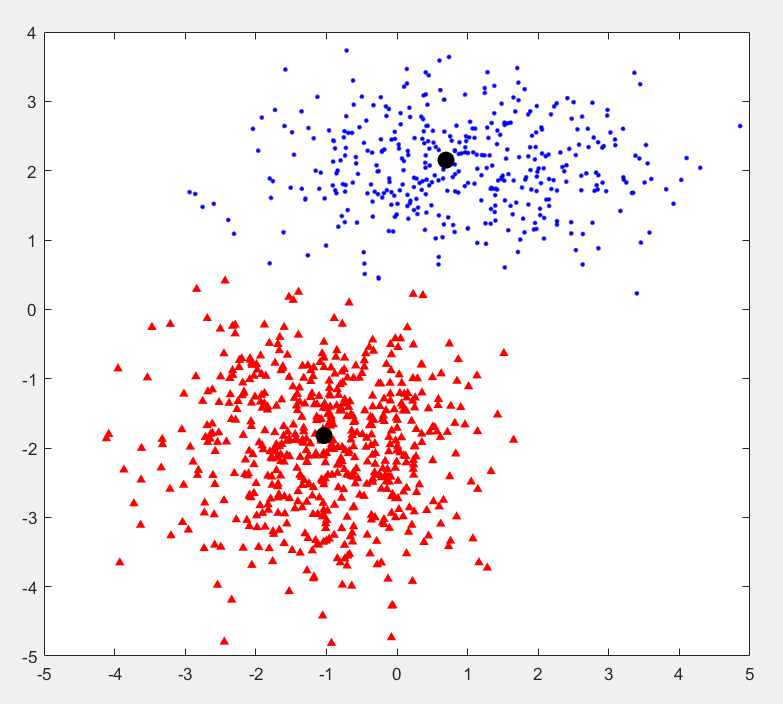密度峰值聚类算法MATLAB程序
凯鲁嘎吉 - 博客园 http://www.cnblogs.com/kailugaji/
密度峰值聚类算法简介见:密度峰值聚类算法(DPC)
数据见:MATLAB中“fitgmdist”的用法及其GMM聚类算法,保存为gauss_data.txt文件,数据最后一列是类标签。也可以在这里下载数据:DPC数据.rar
1. MATLAB程序
clear all
close all
%% 从文件中读取数据
data_load=dlmread('gauss_data.txt');
[num,dim]=size(data_load); %数据最后一列是类标签
data=data_load(:,1:dim-1); %去掉标签的数据
mdist=pdist(data); %两两行之间距离
A=tril(ones(num))-eye(num);
[x,y]=find(A~=0);
% Column 1: id of element i, Column 2: id of element j', Column 3: dist(i,j)'
xx=[x y mdist'];
ND=max(xx(:,2));
NL=max(xx(:,1));
if (NL>ND)
ND=NL; %% 确保 DN 取为第一二列最大值中的较大者,并将其作为数据点总数
end
N=size(xx,1); %% xx 第一个维度的长度,相当于文件的行数(即距离的总个数)
%% 初始化为零
for i=1:ND
for j=1:ND
dist(i,j)=0;
end
end
%% 利用 xx 为 dist 数组赋值,注意输入只存了 0.5*DN(DN-1) 个值,这里将其补成了满矩阵
%% 这里不考虑对角线元素
for i=1:N
ii=xx(i,1);
jj=xx(i,2);
dist(ii,jj)=xx(i,3);
dist(jj,ii)=xx(i,3);
end
%% 确定 dc
percent=2.0;
fprintf('average percentage of neighbours (hard coded): %5.6f\n', percent);
position=round(N*percent/100); %% round 是一个四舍五入函数
sda=sort(xx(:,3)); %% 对所有距离值作升序排列
dc=sda(position);
%% 计算局部密度 rho (利用 Gaussian 核)
fprintf('Computing Rho with gaussian kernel of radius: %12.6f\n', dc);
%% 将每个数据点的 rho 值初始化为零
for i=1:ND
rho(i)=0.;
end
% Gaussian kernel
for i=1:ND-1
for j=i+1:ND
rho(i)=rho(i)+exp(-(dist(i,j)/dc)*(dist(i,j)/dc));
rho(j)=rho(j)+exp(-(dist(i,j)/dc)*(dist(i,j)/dc));
end
end
%
% "Cut off" kernel
%
%for i=1:ND-1
% for j=i+1:ND
% if (dist(i,j)<dc)
% rho(i)=rho(i)+1.;
% rho(j)=rho(j)+1.;
% end
% end
%end
%% 先求矩阵列最大值,再求最大值,最后得到所有距离值中的最大值
maxd=max(max(dist));
%% 将 rho 按降序排列,ordrho 保持序
[rho_sorted,ordrho]=sort(rho,'descend');
%% 处理 rho 值最大的数据点
delta(ordrho(1))=-1.;
nneigh(ordrho(1))=0;
%% 生成 delta 和 nneigh 数组
for ii=2:ND
delta(ordrho(ii))=maxd;
for jj=1:ii-1
if(dist(ordrho(ii),ordrho(jj))<delta(ordrho(ii)))
delta(ordrho(ii))=dist(ordrho(ii),ordrho(jj));
nneigh(ordrho(ii))=ordrho(jj);
% 记录 rho 值更大的数据点中与 ordrho(ii) 距离最近的点的编号 ordrho(jj)
end
end
end
%% 生成 rho 值最大数据点的 delta 值
delta(ordrho(1))=max(delta(:));
%% 决策图
disp('Generated file:DECISION GRAPH')
disp('column 1:Density')
disp('column 2:Delta')
fid = fopen('DECISION_GRAPH', 'w');
for i=1:ND
fprintf(fid, '%6.2f %6.2f\n', rho(i),delta(i));
end
%% 选择一个围住类中心的矩形
disp('Select a rectangle enclosing cluster centers')
%% 每台计算机,句柄的根对象只有一个,就是屏幕,它的句柄总是 0
%% >> scrsz = get(0,'ScreenSize')
%% scrsz =
%% 1 1 1280 800
%% 1280 和 800 就是你设置的计算机的分辨率,scrsz(4) 就是 800,scrsz(3) 就是 1280
scrsz = get(0,'ScreenSize');
%% 人为指定一个位置
figure('Position',[6 72 scrsz(3)/4. scrsz(4)/1.3]);
%% ind 和 gamma 在后面并没有用到
for i=1:ND
ind(i)=i;
gamma(i)=rho(i)*delta(i);
end
%% 利用 rho 和 delta 画出一个所谓的“决策图”
subplot(2,1,1)
tt=plot(rho(:),delta(:),'o','MarkerSize',5,'MarkerFaceColor','k','MarkerEdgeColor','k');
title ('Decision Graph','FontSize',15.0)
xlabel ('\rho')
ylabel ('\delta')
fig=subplot(2,1,1);
rect = getrect(fig);
%% getrect 从图中用鼠标截取一个矩形区域, rect 中存放的是
%% 矩形左下角的坐标 (x,y) 以及所截矩形的宽度和高度
rhomin=rect(1);
deltamin=rect(2); %% 作者承认这是个 error,已由 4 改为 2 了!
%% 初始化 cluster 个数
NCLUST=0;
%% cl 为归属标志数组,cl(i)=j 表示第 i 号数据点归属于第 j 个 cluster
%% 先统一将 cl 初始化为 -1
for i=1:ND
cl(i)=-1;
end
%% 在矩形区域内统计数据点(即聚类中心)的个数
for i=1:ND
if ( (rho(i)>rhomin) && (delta(i)>deltamin))
NCLUST=NCLUST+1;
cl(i)=NCLUST; %% 第 i 号数据点属于第 NCLUST 个 cluster
icl(NCLUST)=i; %% 逆映射,第 NCLUST 个 cluster 的中心为第 i 号数据点
end
end
fprintf('NUMBER OF CLUSTERS: %i \n', NCLUST);
disp('Performing assignation')
%assignation
%% 将其他数据点归类 (assignation)
for i=1:ND
if (cl(ordrho(i))==-1)
cl(ordrho(i))=cl(nneigh(ordrho(i)));
end
end
%halo
%% 由于是按照 rho 值从大到小的顺序遍历,循环结束后, cl 应该都变成正的值了.
%% 处理光晕点,halo这段代码应该移到 if (NCLUST>1) 内去比较好吧
for i=1:ND
halo(i)=cl(i);
end
if (NCLUST>1)
% 初始化数组 bord_rho 为 0,每个 cluster 定义一个 bord_rho 值
for i=1:NCLUST
bord_rho(i)=0.;
end
% 获取每一个 cluster 中平均密度的一个界 bord_rho
for i=1:ND-1
for j=i+1:ND
%% 距离足够小但不属于同一个 cluster 的 i 和 j
if ((cl(i)~=cl(j))&& (dist(i,j)<=dc))
rho_aver=(rho(i)+rho(j))/2.; %% 取 i,j 两点的平均局部密度
if (rho_aver>bord_rho(cl(i)))
bord_rho(cl(i))=rho_aver;
end
if (rho_aver>bord_rho(cl(j)))
bord_rho(cl(j))=rho_aver;
end
end
end
end
%% halo 值为 0 表示为 outlier
for i=1:ND
if (rho(i)<bord_rho(cl(i)))
halo(i)=0;
end
end
end
%% 逐一处理每个 cluster
for i=1:NCLUST
nc=0; %% 用于累计当前 cluster 中数据点的个数
nh=0; %% 用于累计当前 cluster 中核心数据点的个数
for j=1:ND
if (cl(j)==i)
nc=nc+1;
end
if (halo(j)==i)
nh=nh+1;
end
end
fprintf('CLUSTER: %i CENTER: %i ELEMENTS: %i CORE: %i HALO: %i \n', i,icl(i),nc,nh,nc-nh);
end
cmap=colormap;
for i=1:NCLUST
ic=int8((i*64.)/(NCLUST*1.));
subplot(2,1,1)
hold on
plot(rho(icl(i)),delta(icl(i)),'o','MarkerSize',8,'MarkerFaceColor',cmap(ic,:),'MarkerEdgeColor',cmap(ic,:));
end
subplot(2,1,2)
disp('Performing 2D nonclassical multidimensional scaling')
Y1 = mdscale(dist, 2, 'criterion','metricstress');
plot(Y1(:,1),Y1(:,2),'o','MarkerSize',2,'MarkerFaceColor','k','MarkerEdgeColor','k');
title ('2D Nonclassical multidimensional scaling','FontSize',15.0)
xlabel ('X')
ylabel ('Y')
for i=1:ND
A(i,1)=0.;
A(i,2)=0.;
end
for i=1:NCLUST
nn=0;
ic=int8((i*64.)/(NCLUST*1.));
for j=1:ND
if (halo(j)==i)
nn=nn+1;
A(nn,1)=Y1(j,1);
A(nn,2)=Y1(j,2);
end
end
hold on
plot(A(1:nn,1),A(1:nn,2),'o','MarkerSize',2,'MarkerFaceColor',cmap(ic,:),'MarkerEdgeColor',cmap(ic,:));
end
%for i=1:ND
% if (halo(i)>0)
% ic=int8((halo(i)*64.)/(NCLUST*1.));
% hold on
% plot(Y1(i,1),Y1(i,2),'o','MarkerSize',2,'MarkerFaceColor',cmap(ic,:),'MarkerEdgeColor',cmap(ic,:));
% end
%end
faa = fopen('CLUSTER_ASSIGNATION', 'w');
disp('Generated file:CLUSTER_ASSIGNATION')
disp('column 1:element id')
disp('column 2:cluster assignation without halo control')
disp('column 3:cluster assignation with halo control')
for i=1:ND
fprintf(faa, '%i %i %i\n',i,cl(i),halo(i));
end
2. 结果
>> demo_gauss average percentage of neighbours (hard coded): 2.000000 Computing Rho with gaussian kernel of radius: 0.393945 Generated file:DECISION GRAPH column 1:Density column 2:Delta Select a rectangle enclosing cluster centers NUMBER OF CLUSTERS: 2 Performing assignation CLUSTER: 1 CENTER: 166 ELEMENTS: 403 CORE: 403 HALO: 0 CLUSTER: 2 CENTER: 835 ELEMENTS: 597 CORE: 597 HALO: 0 Performing 2D nonclassical multidimensional scaling Generated file:CLUSTER_ASSIGNATION column 1:element id column 2:cluster assignation without halo control column 3:cluster assignation with halo control

得到聚类中心是第166与第835个数据样本。
注:出错的话,将Y1 = mdscale(dist, 2, 'criterion','metricstress');换一个准则函数,比如改为Y1 = mdscale(dist, 2, 'criterion','sstress');
mdscale()为多维尺度降维函数,将两两距离降到2维
icl为选出的簇中心在原始数据上的id
3. 绘制原始数据聚类后的2D结果图
3.1 程序
clear
clc
data_load=dlmread('gauss_data.txt');
train_label_load=dlmread('CLUSTER_ASSIGNATION'); % 加载聚类结果
[num,dim]=size(data_load); %数据最后一列是类标签
data=data_load(:,1:dim-1); %去掉标签的数据
train_label=train_label_load(:, 2);
data_new=[data train_label];
figure(1)
plot(data_new(data_new(:, end)==1, 1), data_new(data_new(:, end)==1, 2), 'b.', 'MarkerSize',8);
hold on
plot(data_new(data_new(:, end)==2, 1), data_new(data_new(:, end)==2, 2), 'r^', 'MarkerSize',4, 'MarkerFaceColor','r');
% 两个中心
center1= data_new(166, 1:2);
center2= data_new(835, 1:2);
hold on
plot(center1(1), center1(2), 'k.', 'MarkerSize', 35);
plot(center2(1), center2(2), 'k.', 'MarkerSize',35);
saveas(gcf,sprintf('Plot 2D.jpg'),'bmp'); %保存图片
3.2 结果



